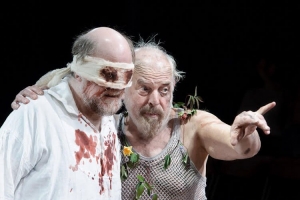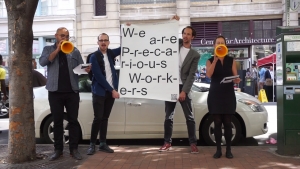
Marx, Shakespeare, King Lear and the modern precariat
Jenny Farrell outlines a Marxist reading of Shakespeare, and illustrates it with an analysis of Shakespeare's King Lear.
Among Marxism’s core insights is that all history since the end of the primitive society has been a history of class societies and class struggle. Art does not arise in a vacuum; it is an integral part of the historical process and of human comprehension of the world. Therefore, the most appropriate way of reaching the core of a work of art is to understand it in the context of the time in which it originates and the social forces of that epoch.
With Shakespeare an art arises that is historically self-aware, conscious that the reality it represents is historical. Historical change is rooted in Shakespeare’s plays. They are built around a historical conflict. The task of interpretation – in both theatre and criticism – is to grasp this basic conflict. Any serious attempt to comprehend Shakespeare’s plays is to understand the time from which they come, the late Renaissance, early 17th c England: the early modern period as a time of epochal upheavals, the formation of the first phase of bourgeois society in which Shakespeare’s theatre originates.
In his tragedies, Shakespeare presents the fundamental conflict of opposing historical forces that arose after the collapse of the medieval world and the rise of the early bourgeoisie. These opposing forces within the bourgeoisie – in terms taken from the Renaissance – are humanism and Machiavellianism; humanism in the sense of an Erasmus of Rotterdam and Thomas More, Machiavellianism after Niccolò Machiavelli, author of The Prince, the famous breviary on gaining and retaining power.
A third force involved in the basic constellation are the representatives of the old order, the mediaeval-feudal world. The fourth player in this overall constellation is the plebeian element, the working people, who are given a voice for the first time as gravediggers in Hamlet. The conflict of the tragedies originates within these forces.
A Marxist reading of King Lear
The main social forces in the play:
Lear (doubled by Gloucester) is an absolute feudal monarch who has lost touch with his people and with his own understanding. His is the strictly ordered feudal world, where a person’s place within the hierarchy was clearly defined and could not be changed. Lear is incapable of understanding the kind of disrespect shown to him by his elder daughters. Their disregard for him and for his dignity once he has handed over his power and his kingdom to them shatters his world completely. When he abandons the society he has known, and is indeed ejected from it by these daughters, he enters the heath as a naked man, a man who has lost everything.
The tempest that rages on the heath is symbolic of what is going on in Lear’s head. In the middle of this violent storm, in the territory of the poor and “mad,” Lear gains a profound understanding of the condition of the dispossessed. Before he enters the hovel he prays for “you houseless poverty” for the homeless. He realises:
Poor naked wretches, whereso’er you are,
That bide the pelting of this pitiless storm,
How shall your houseless heads and unfed sides,
Your looped and windowed raggedness, defend you
From seasons such as these? Oh, I have ta’en
Too little care of this! Take physic, pomp.
Expose thyself to feel what wretches feel,
That thou mayst shake the superflux to them
And show the heavens more just.
As he is exposed to the poor and the homeless, the evicted, he realises that this is going on in his own kingdom and that he has not taken an interest in the wretched. This insight is not madness but the opposite of madness. When Lear encounters Edgar, who pretends to be a mad beggar dressed in the most meagre of rags, if not indeed naked, his insight goes further again:
Thou art the thing itself. Unaccommodated man is no more but such a poor, bare, forked animal as thou art.—Off, off, you lendings! Come. Unbutton here. (tears at his clothes)
Here he discovers essential humanity, “the thing itself,” “unaccommodated man.” This is a crucial moment in Lear’s development. Symbolically, to emphasise this new understanding he tears off his clothes. Of course, there are also expressions of genuine madness, sometimes simply for comic relief; but very often there is hidden reason in these, such as in Lear’s mock trial of Goneril and Regan, with Edgar and the Fool as judges. He asks:
Then let them anatomise Regan. See what breeds about her heart. Is there any cause in nature that makes these hard hearts?
Lear here seeks a scientific, objective examination of what makes hard hearts. He has come a long way. Later in the play, when Lear meets the blinded Gloucester near Dover, he continues to be “unhinged,” commenting on social injustice:
A man may see how this world goes with no eyes. Look with thine ears. See how yon justice rails upon yon simple thief. Hark in thine ear: change places and, handy-dandy, which is the justice, which is the thief?
Or he observes:
Through tattered clothes great vices do appear;
Robes and furred gowns hide all. Plate sin with gold,
And the strong lance of justice hurtless breaks.
Arm it in rags, a pigmy’s straw does pierce it.
Edgar too recognises Lear’s deep new understanding, remarking: “Reason in madness”. This is a profound growth in humanity in Lear. Lear’s destruction means the loss of his new understanding of the plight of the dispossessed, his appreciation of the fundamental equality of human beings, the loss of his new humanity. This makes his death tragic.
Goneril, Regan, Edmund and Cornwall are the self-interested younger-generation Machiavellians in this play. It is clear to the audience from the start that they are adept at deception. However, just how inhuman they are is revealed only in their actions over time. In many ways they seem quite modern to us in their thinking and acting. Genuine affection, honesty and loyalty mean nothing to them; personal gain is everything, even if it costs the dignity and life of others.
Cordelia and Edgar are established as independent, loyal characters (Edgar after being initially deceived by the Machiavellian brother), willing to sacrifice their lives for justice. Cordelia and Edgar embody the tradition of Renaissance humanism; they are wise, honest and loyal and have a sense of the common good. Although Cordelia dies as a result of Edmund’s machinations, Edgar, who is proclaimed king by Albany, vows to rule in her spirit.
What is the play about?
The threat of a new Machiavellian order
A major theme in this play is the cataclysmic clash of social orders: the old absolute, feudal monarch is deprived of his royal status and power, his dignity, his right to house and home, by his elder daughters, the new Machiavellian generation. Alongside the dangerous, indeed murderous new power there are humanist forces that are in a position to lead society forward in an inclusive, honest and humane way.
Good kingship or leadership
In this play, as in Hamlet and Macbeth, Shakespeare brings to the fore the question of what makes a good leader, or king. Such leaders must be, above all, honest and wise and must act in the interests of the common good. Good leaders must be willing to sacrifice their lives in the defeat of evil forces.
The fundamental equality of humankind
Lear, the anointed king, is driven into a space outside this new society. At that moment, he shares his life with the naked wretches of his realm, recognises and affirms their common humanity. This in turn makes him realise the enormous social inequity and corruption in his kingdom, wrongs for which he is responsible. Ultimately, his experience leads him to understand that only a fair distribution of wealth can remedy this.
Social injustice created by social hierarchy
All the outcasts on the heath arrive at an understanding that the way things are in England is wrong. All of them describe corruption, the ignorance of the powerful, and the indifference towards the poor. They all envisage the possibility of a different kind of society, one in which, as the Fool says, the world will be put on its feet. This theme of a utopia, of what might be, is inherent in the central themes of the play.
Shakespeare is still relevant today. His plays are not about some hazy universal human condition – unchanging and unchangeable. His tragedies are rooted in history, in early capitalism. They are about his times and therefore about our times.
In an expression of their new historical place in early 17th c Britain, the bourgeoisie developed both a humanist and a Machiavellian rationale. These are two sides of the same society, its potential for both a utopian and a totalitarian direction. In the tragedies both potentials are put on stage, as well as characters caught in between. Interestingly, while we see a number of “pure” Machiavellians, few characters are cast as “pure” Christian princes or princesses, in Erasmus’s terms; examples might be King Edward I in “Macbeth” or even Cordelia in “King Lear”. These characters are often in the background, like a moral compass.
Instead, Shakespeare finds the idealised Renaissance image of humankind scattered among a number of people. The human potential that many of his characters show combines into a future vision of a social order commensurate with the needs of humankind and so points into the future of humanity. In this respect, Shakespeare’s positive characters are of their time and also born before their time in terms of their potential.
The Machiavellians present the greatest danger to the common good. They are depicted as dangerous and murderous. In each case their inhumanity causes the downfall of the tragic hero. Shakespeare’s historical optimism at the beginning of the era in which we still live allows him to end his tragedies with the destruction of the Machiavellians.
By revealing the nature of the epoch Shakespeare alerts us to the dangers. He points to who is the enemy of humanity and who fights to preserve it. In this sense, Shakespeare is not simply of historical interest, he has something valuable to contribute when we think about the times we live in now and our future.
King Lear takes the gravediggers’ understanding of human equality in Hamlet to a different level. Lear’s literal nakedness on the heath marks an unparalleled insight into common human nature and identification with the poorest of the poor. Lear discovers human dignity when he is stripped of everything.
In today’s world, the plight of the precariat and of refugees comes close to what Shakespeare was illustrating. Lear’s recognition of human dignity, of social injustice, and the need for an equal distribution of wealth, has lost none of its urgency. By putting before his audience the very essence of his time, and thereby ours, Shakespeare shows how it can and must change. This is what makes his plays so important for us now.
Jenny Farrell is the author of “Fear Not Shakespeare’s Tragedies. A Comprehensive Introduction.” Nuascéalta, 2016.



